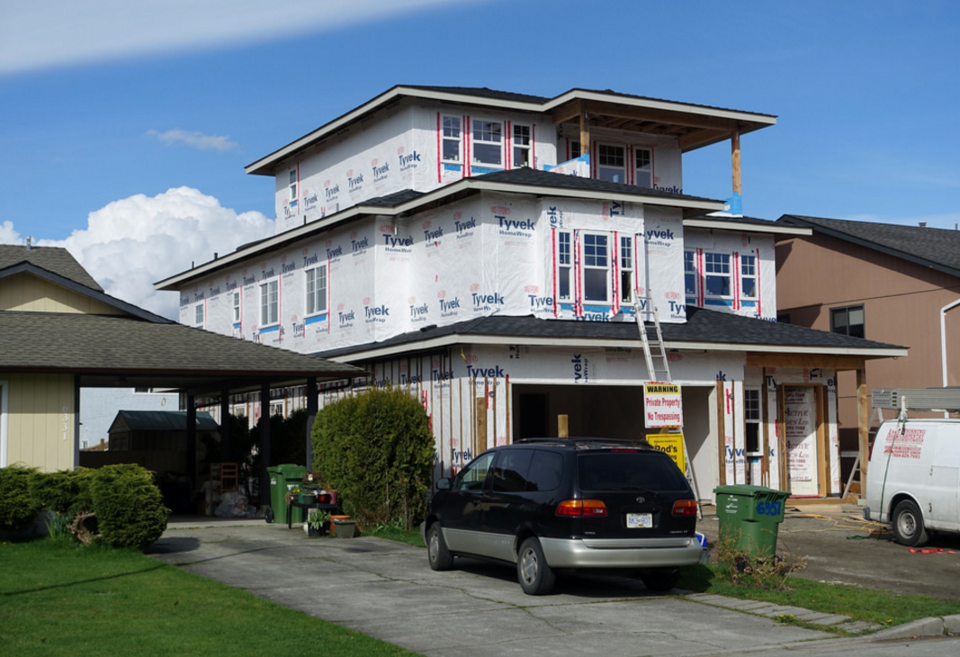A mega public hearing on proposed changes to single-family housing regulations is set for Tuesday evening.
The City of Richmond is proposing to terminate the land-use contracts of roughly 4,000 detached residential properties in the city.
Richmond city council will preside over the special hearing, which could span days, depending on how many members of the public show up at 7 p.m. to the Executive Airport Plaza Hotel to speak.
“I’ve been told (by city staff) this is the largest public hearing process the city has undertaken since the Terra Nova development,” said Coun. Linda McPhail.
“We’re in unchartered waters the way I see it. …It’s not a rubber stamp deal,” said Coun. Ken Johnston.
Land-use contracts (LUC) are said to be partly responsible for the proliferation of mega homes throughout the city’s older, established neighbourhoods.
That’s because land-use contracts overrule the city’s residential zoning bylaws, meaning new homes on LUC properties can be built larger and several feet higher than is allowed for non-LUC properties.
As a result, McPhail said she has heard anecdotes that LUC properties are being bought up in order to develop prior to the termination of the contracts.
City spokesman Ted Townsend estimates about 100 LUC properties have been developed in the last “few years.”
The contracts were established in the 1970s (by provincial authorities) and, according to the city, do not reflect modern zoning regulations. McPhail said after lobbying efforts by the city since 2009, the province has allowed — as of spring 2014 — municipalities to terminate the contracts early (they will otherwise expire in 2024).
Once terminated, the properties in question will be governed by the city’s bylaws.
The city contends bringing the LUC properties under the city’s zoning bylaws will ensure core development regulations — such as the height of a new home, or how close it can be built next to an existing one — are applied consistently.
Many neighbourhoods have LUC properties speckled throughout them, meaning on a single street a new house built on an LUC property can overshadow a house built on a property dictated by city bylaws.
A common complaint amongst residents has been newly built three-storey homes with balconies looming over neighbouring backyards.
Earlier this year, council amended residential zoning bylaws to disallow third-storey balconies, reduce the height of new homes to 29 feet as well as shrink the allowable building envelope (mass/volume). However, such changes cannot legally be applied to LUC properties until the contracts are terminated.
Many developers and homebuilders have lamented the termination proposal, claiming the opportunity to build a bigger home can result in higher land value.
“I assume most people that do come will be discussing the valuation of their property,” said Johnston.
The most outspoken critic of LUCs at recent council committee meetings has been realtor Lynda Terborg, who claims they have created a mish-mash of housing size in well-planned neighbourhoods.
Terborg said homeowners without land-use contracts should also voice their opinions at the hearing.
“Whether you own an LUC property, or live beside, behind or across the street from one, the city can hear your views,” said Terborg, who noted that with the demolition of more than 500 homes annually, the matter is one of “quality of life.”
Coun. Harold Steves, who favours early LUC termination, said what property owners may lose in value by not being able to build tall homes, will be gained back in being able to use their homes for secondary uses (suites, boarding, home businesses), which are not allowed on LUC properties.
According to what is being proposed, roughly 95 per cent of the affected LUC properties will subsequently fall under the RS1 zoning designation one year after the contracts are terminated (meaning a property owner can still submit a building permit under LUC rules by Dec. 1, 2016).
Should council terminate the contracts and a resident disagrees with the decision, he or she may apply for an appeal with the council-appointed, citizen-led Board of Variance. In doing so, the resident must prove “hardship” has been caused by the termination (although “hardship” has yet to be defined by the board).
One resident who disagrees with the termination process is David Currie, who lives in the same neighbourhood (Westwind) as Terborg.
Currie said builders have told him the value of his property, which falls under a land-use contract, could be affected.
“My real bottom line opinion is we should let this run its course,” said Currie, who added the issue of new homes conforming to established neighbourhoods is more about home design than the height of homes.
In order to hold the hearing, McPhail said the city issued roughly 20,000 booklets to affected residents. It also established an LUC hotline for residents to ask questions (up to 24 calls per day are received).



